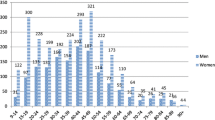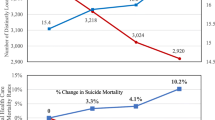Abstract
A sizeable proportion of all suicides have mental health issues in the background. The association between access to mental health care in the community and decreased suicide rates is inconsistent in the literature. Brazil undertook a major psychiatric reform strengthening psychiatric community-based care. To evaluate the impact of the new Brazilian community mental health care units (CAPS-Psychosocial-Community-Centres) on municipal rates of suicide, and hospitalisations by attempted suicide, psychiatric and alcohol problems. We performed robust multivariable negative binomial regression models with fixed effect for panel data from all 5507 Brazilian municipalities. Suicide and hospitalization rates were calculated by sex and standardised by age for each municipality and year from 2008 to 2012. The main variable of interest was municipal CAPS coverage. CAPS municipal coverage was associated with lower suicide rates but this was not statistically significant (RR: 0.981; 95% CI 0.952–1.011). However, increased CAPS coverage was associated with lower hospitalizations for attempted suicide (RR: 0.887; 95% CI 0.841–0.935), psychiatric (RR: 0.841; 95% CI 0.821–0.862), and alcohol problems (RR: 0.882; 95% CI 0.860–0.904). Our results suggest that access to community mental health services seems to reduce hospitalisations due to attempted suicide, psychiatric and alcohol problems but not suicidal rates. Therefore, increased investments in community mental health services in low-middle-income countries might decrease costs associated with potentially avoidable hospitalizations.
Similar content being viewed by others
References
Alavi, A., Sharifi, B., Ghanizadeh, A., & Dehbozorgi, G. (2013). Effectiveness of cognitive-behavioral therapy in decreasing suicidal ideation and hopelessness of the adolescents with previous suicidal attempts. Iranian Journal of Pediatrics, 23(4), 467.
Andrade, L. H., Wang, Y. P., Andreoni, S., Silveira, C. M., Alexandrino-Silva, C., Siu, E. R., …& Viana, M. C. (2012). Mental disorders in megacities: findings from the Sao Paulo megacity mental health survey, Brazil. PloS ONE, 7(2), e31879.
Anglemyer, A., Horvath, T., & Rutherford, G. (2014). The accessibility of firearms and risk for suicide and homicide victimization among household membersa systematic review and meta-analysis. Annals of Internal Medicine, 160(2), 101–110.
Becker, A. E., & Kleinman, A. (2013). Mental health and the global agenda. New England Journal of Medicine, 369(1), 66–73.
Bertolote, J. M., Fleischmann, A., De Leo, D., & Wasserman, D. (2004). Psychiatric diagnoses and suicide: revisiting the evidence. Crisis, 25(4), 147–155.
Brasil. Ministério da Saúde. (2011a). Portaria nº 3.088, de 23 de dezembro de 2011. Institui a Rede de AtençãoPsicossocial para pessoas com sofrimentooutranstorno mental e com necessidadesdecorrentes do uso de crack, álcool e outrasdrogas, no âmbito do Sistema Único de Saúde. DiárioOficial da RepúblicaFederativa do Brasil, (247).
Brasil. Ministério da Saúde. (2011b). Saúde Mental em Dados – 8, ano VI, nº 8. Informativo eletrônico. Brasília. Recovered in August 2016 from: http://www.saude.gov.br.
Brasil. Ministério da Saúde. (2009). Portaria nº 2.669, de 3 de novembro de 2009. Estabelece as prioridades, objetivos, metas e indicadores de monitoramento e avaliação do Pacto pela Saúde, noscomponentes pela Vida e de Gestão, e as orientações, prazos e diretrizes do seuprocesso de pactuação para o biênio 2010–2011. Ministério da Saúde.
Brasil. Ministério da Saúde. (2007). Saúde Mental em Dados. Secretaria de Atenção à Saúde. Departamento de Ações Programáticas e Estratégicas. Coordenação Geral de Saúde Mental: Ministério da Saúde.
Brasil. Ministério da Saúde. (2013). Secretaria de Gestão Estratégica e Participativa. Departamento de ArticulaçãoInterfederativa. Caderno de diretrizes, Objetivos: pp. 2013–2015.
Brasil. Departamento de Ações Programáticas Estratégicas. (2004). Saúde mental no SUS: oscentros de atençãopsicossocial. Ministério da Saúde.
Brasil. Ministério da Saúde. (2001). Manual de instruções para o preenchimento da declaração de óbito : 3. ed.. Brasília : Ministério da Saúde : Fundação Nacional de Saúde. Mortalidade. 2. Sistema de Informações. I. Brasil. Ministério da Saúde. II. Brasil. FundaçãoNacional de Saúde.
Brasil. Ministério da Saúde (2003). Política nacional de atenção às urgências. Brasília: Ministério da Saúde 228 p.: il. – (Série E. Legislação de Saúde) 1. Serviços Médicos de Emergência. 2. Legislação Sanitária. I. Brasil. Ministério da Saúde. II. Título. III. Série.
Brasil. Ministério da Saúde. (2005). Reforma psiquiátrica e política de saúde mental no Brasil. Brasília: Ministério da Saúde.
Brasil. Ministério da Saúde. (2006). Prevenção do Suicídio: manual dirigido a profissionais das equipes de saúde mental.
Campo, J. V. (2009). Youth suicide prevention: Does access to care matter? Current opinion in pediatrics, 21(5), 628–634.
Daigle, M. S., Pouliot, L., Chagnon, F., Greenfield, B., & Mishara, B. (2011). Suicide attempts: Prevention of repetition. The Canadian Journal of Psychiatry, 56(10), 621–629.
Datasus. (2017). Recovered in September 2016 from: http://www2.datasus.gov.br/DATASUS/index.php?area=0204&id=6906&VObj=http://tabnet.datasus.gov.br/cgi/deftohtm.exe?cnes/cnv/estab.
Harris, E. C., & Barraclough, B. (1997). Suicide as an outcome for mental disorders. A meta-analysis. The British Journal of Psychiatry, 170(3), 205–228.
Hawton, K., & Van, H. K. (2009). Suicide. The Lancet, 373(9672), 1372–1381 [Peer Reviewed Journal].
Haynes, R., Lovett, A., Reading, R., Langford, I. H., & Gale, S. (1999). Use of homogeneous social areas for ecological analyses: A study of accident rates in pre school children. The European Journal of Public Health, 9(3), 218–222.
Hilbe, J. M. (2011). Negative binomial regression. Cambridge: Cambridge University Press.
Holt-Lunstad, J., Smith, T. B., Baker, M., Harris, T., & Stephenson, D. (2015). Loneliness and social isolation as risk factors for mortality: a meta-analytic review. Perspectives on Psychological Science, 10(2), 227–237.
Hom, M. A., Stanley, I. H., & Joiner, T. E. (2015). Evaluating factors and interventions that influence help-seeking and mental health service utilization among suicidal individuals: a review of the literature. Clinical Psychology Review, 40, 28–39.
Instituto Brasileiro de Geografia e Estatística (IBGE). (n.d.). Recovered in September 2016 from: http://www.ibge.gov.br/home.
Johannessen, H. A., Dieserud, G., Claussen, B., & Zahl, P. H. (2011). Changes in mental health services and suicide mortality in Norway: an ecological study. BMC Health Services Research, 11(1), 68.
Jorge, M. H. P. D. M., Gotlieb, S. L. D., & Laurenti, R. (2002). O sistema de informaçõessobremortalidade: problemas e propostas para o seuenfrentamento II-Mortesporcausasexternas. RevistaBrasileira de Epidemiologia, 5(2), 212–223.
Kapusta, N. D., Niederkrotenthaler, T., Etzersdorfer, E., Voracek, M., Dervic, K., Jandl-Jager, E., & Sonneck, G. (2009). Influence of psychotherapist density and antidepressant sales on suicide rates. Acta Psychiatrica Scandinavica, 119(3), 236–242.
Kleck, G. (2004). Measures of gun ownership levels for macro-level crime and violence research. Journal of Research in Crime and Delinquency, 41(1), 3–36.
Kõlves, K., Milner, A., & Värnik, P. (2013). Suicide rates and socioeconomic factors in Eastern European countries after the collapse of the Soviet Union: trends between 1990 and 2008. Sociology of Health & Illness, 35(6), 956–970.
Machado, D. B., Rasella, D., & Dos Santos, D. N. (2015). Impact of income inequality and other social determinants on suicide rate in Brazil. PloS ONE, 10(4), e0124934.
Mortensen, P. B., Agerbo, E., Erikson, T., Qin, P., & Westergaard-Nielsen, N. (2000). Psychiatric illness and risk factors for suicide in Denmark. The Lancet, 355(9197), 9–12.
Neri, M. C., & Souza, P. H. C. F. D. (2012). A décadainclusiva (2001–2011): desigualdade, pobreza e políticas de renda.
Nock, M. K., Borges, G., Bromet, E. J., Cha, C. B., Kessler, R. C., & Lee, S. (2008). Suicide and suicidal behavior. Epidemiologic Reviews, 30(1), 133–154.
Nordentoft, M., Madsen, T., & Fedyszyn, I. (2015) Suicidal behaviour and mortality in first-episode psychosis. The Journal of nervous and mental disease, 203(5):387–392. doi:10.1097/NMD.0000000000000296.
Paim, J. S., & Almeida Filho, N. D. (2014). Saúdecoletiva: teoria e prática. Saúdecoletiva: teoria e prática. MedBook.
Patel, V., & Thornicroft, G. (2009). Packages of care for mental, neurological, and substance use disorders in low-and middle-income countries: PLoS Medicine Series. PLoS Medicine, 6(10), e1000160.
Pirkola, S., Sund, R., Sailas, E., & Wahlbeck, K. (2009). Community mental-health services and suicide rate in Finland: a nationwide small-area analysis. The Lancet, 373(9658), 147–153.
Reichenheim, M. E., De Souza, E. R., Moraes, C. L., de Mello Jorge, M. H. P., Da Silva, C. M. F. P., & de Souza Minayo, M. C. (2011). Violence and injuries in Brazil: the effect, progress made, and challenges ahead. The Lancet, 377(9781), 1962–1975.
Robinson, J., Hetrick, S. E., & Martin, C. (2011). Preventing suicide in young people: systematic review. Australian and New Zealand Journal of Psychiatry, 45(1), 3–26.
Ross, J. M., Yakovlev, P. A., & Carson, F. (2012). Does state spending on mental health lower suicide rates? The Journal of Socio-Economics, 41(4), 408–417.
Santos, É. G. D., & &Siqueira, M. M. D. (2010). Prevalência dos transtornosmentaisnapopulaçãoadultabrasileira: umarevisãosistemática de 1997 a 2009. J. bras. psiquiatr, 59(3), 238–246.
Scheffler, R. M., & World Health Organization (WHO). (2011). Human resources for mental health: Workforce shortages in low-and middle-income countries.
Stack, S. (2000). Suicide: a 15-year review of the sociological literature part I: cultural and economic factors. Suicide and Life-Threatening Behavior, 30(2), 145–162.
Szwarcwald, C. L. (2008). Strategies for improving the monitoring of vital events in Brazil. International Journal of Epidemiology, 37(4), 738–744.
Tarrier, N., Taylor, K., & Gooding, P. (2008). Cognitive-behavioral interventions to reduce suicide behavior: a systematic review and meta-analysis. Behavior Modification, 32(1), 77–108.
Tondo, L., Albert, M. J., & Baldessarini, R. J. (2006). Suicide rates in relation to health care access in the United States: an ecological study. The Journal of Clinical Psychiatry, 67(4), 517–523.
Victora, C. G., Aquino, E. M., do Carmo Leal, M., Monteiro, C. A., Barros, F. C., & Szwarcwald, C. L. (2011). Maternal and child health in Brazil: progress and challenges. The Lancet, 377(9780), 1863–1876.
Wakefield, J. (2008). Ecologic studies revisited. Annual Review of Public Health, 29, 75–90.
Wang, P. S., Aguilar-Gaxiola, S., Alonso, J., Angermeyer, M. C., Borges, G., Bromet, E. J., …& Haro, J. M. (2007). Use of mental health services for anxiety, mood, and substance disorders in 17 countries in the WHO world mental health surveys. The Lancet, 370(9590), 841–850.
Wasserman, D., Rihmer, Z., Rujescu, D., Sarchiapone, M., Sokolowski, M., Titelman, D., & Carli, V. (2012). The European Psychiatric Association (EPA) guidance on suicide treatment and prevention. European psychiatry, 27(2), 129–141.
While, D., Bickley, H., Roscoe, A., Windfuhr, K., Rahman, S., Shaw, J., & Kapur, N. (2012). Implementation of mental health service recommendations in England and Wales and suicide rates, 1997–2006: A cross-sectional and before-and-after observational study. The Lancet, 379(9820), 1005–1012.
Whitlock, E. P., Polen, M. R., Green, C. A., Orleans, T., & Klein, J. (2004). Behavioralcounseling interventions in primary care to reduce risky/harmful alcohol use by adults: a summary of the evidence for the US Preventive Services Task Force. Annals of Internal Medicine, 140(7), 557–568.
Williams, M. E., Latta, J., & Conversano, P. (2008). Eliminating the wait for mental health services. The Journal of Behavioral Health Services & Research, 35(1), 107–114.
Wooldridge, J. M. (2015). Introductory econometrics: A modern approach. Scarborough: Nelson Education.
World Bank Data. (2017). World Bank country and lending groups. Recovered in October 2016 from:https://datahelpdesk.worldbank.org/knowledgebase/articles/906519-world-bank-country-and-lending-groups.
World Health Organization (WHO). (1994). Guidelines for the primary prevention of mental, neurological and psychosocial disorders. 5. Staff burnout.
World Health Organization (WHO). (2010a). International classification of diseases (ICD). http://apps.who.int/classifications/apps/icd/icd10online/.
World Health Organization (WHO). (2010b). Prevenção do Suicídio: um recurso para conselheiros: Genebra: OMS.. Geneva: World Health Organization
World Health Organization (WHO). (2014). Preventing suicide: a global imperative. Recovered in March 2016 from:http://apps.who.int/iris/bitstream/10665/131056/8/9789241564878_eng.pdf?ua=1&ua=1.
World Health Organization (WHO). (2015a). Mental health action plan 2013–2020.; 2013. WHO web site http://scholar.google.com/scholar.
World Health Organization (WHO). (2015b). Mental health atlas 2014. Geneva: World Health Organization.
Ying, Y. H., & Chang, K. (2009). A study of suicide and socioeconomic factors. Suicide and life-threatening behavior, 39(2), 214–226.
Author information
Authors and Affiliations
Corresponding author
Rights and permissions
About this article
Cite this article
Machado, D.B., Alves, F.J., Rasella, D. et al. Impact of the New Mental Health Services on Rates of Suicide and Hospitalisations by Attempted Suicide, Psychiatric Problems, and Alcohol Problems in Brazil. Adm Policy Ment Health 45, 381–391 (2018). https://doi.org/10.1007/s10488-017-0830-1
Published:
Issue Date:
DOI: https://doi.org/10.1007/s10488-017-0830-1




